Papers by Matthew Brown
Bulletin of Latin American Research, 2008
This introduction presents this collectively authored, interdisciplinary interrogation of the con... more This introduction presents this collectively authored, interdisciplinary interrogation of the concept of British 'informal empire' in Latin America. Published in 2008, Informal Empire in Latin America drew together a range of fantastic scholars to discuss, debate and redefine the concept and to think together about British relations with Latin America in the nineteenth and twentieth centuries.

Jahrbuch für Geschichte Lateinamerikas, 2005
This article looks at the rebellion of the Irish Legion at Riohacha, New Granada (Colombia), in 1... more This article looks at the rebellion of the Irish Legion at Riohacha, New Granada (Colombia), in 1820. It highlights the Atlantic networks of politics, commerce, and migration upon which Colombia's independence from Spain took place. These networks catalysed thinking about changing notions of masculinities and collective identities in this period. The sources for the article are archival documents in Dublin and Bogotá, and newspaper reports and private correspondence that reflected on the events in question. The Irish Legion served the cause of Independence in Colombia under the command of Simón Bolívar, and it was largely envisaged as a brave and generous Irish contribution to the cause of liberty. The Legion's rebellion thus caused numerous reinterpretations of their motives, both at home in Ireland and amongst Hispanic Americans. The article provides a brief narrative of events and traces the ripples of their consequences in Riohacha itself and away in Bogotá. The study emphasises how identity formation in early nineteenth-century Hispanic America (including local, regional, national, colonial, and imperial identities) was a flexible and contested process based on understandings of masculinity and race, and influenced by often unexpected events such as hunger, looting, ambush, and desertion.
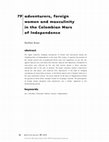
Feminist Review, 2005
This paper examines changing conceptions of honour and masculinity during the Colombian Wars of I... more This paper examines changing conceptions of honour and masculinity during the Colombian Wars of Independence in the early 19th century. It explores the position of the foreign women who accompanied British and Irish expeditions to join the war against Spanish rule, and shows how colonial, imperial and republican conceptions of masculinity were affected by the role that women played in these volunteer expeditions and in the wars in general. The paper considers women's experiences during war and peace, and examines their experiences in the light of changing conceptions of masculinity at home, in the British empire and in Hispanic America in the early nineteenth century. The social mobility of the Wars of Independence shifted the ground on which these concepts rested for all groups involved. The participation of foreign women alongside male adventurers was a further ingredient in this disorientating period.
Estudos historicos, 2019
This article explores the early history of Association Football in South America through the case... more This article explores the early history of Association Football in South America through the case study of the first
translations of the rules of the game from English into Portuguese and Spanish. It demonstrates, by means of a
comparison of the different temporalities and contexts of these documents, the connected and transnational nature
of the sport. This has often been neglected in national paradigm studies of football pioneers and the first matches,
clubs and leagues. The study of the translators suggests new avenues for the study of the interlinked histories of
sport, politics and culture.

International Journal in the History of Sport, 2020
The history of organised cricket in Brazil during the nineteenth century presents a compelling ca... more The history of organised cricket in Brazil during the nineteenth century presents a compelling case study because of its development as an exclusionary social practice around British expatriate communities. In Brazil, cricket was played in many places well before Association Football became the national game. In contrast to cricket in formal British colonies in the West Indies, or English-speaking independent territories in North America, in Brazil the sport did not reach out to social groups that differed from British expatriates in language, ethnicity or social class. Club initiatives created in six Brazilian cities stand out for their economic power and political influence: the national capital (Rio de Janeiro), three state capitals (Niterói, Recife and São Paulo) and Santos and Campinas. Empire and language played a key role in defining sports cultures, as is shown by the periodicals that circulated in these cities in both Portuguese and English.
Latin American Sports Media, 2024
This conclusion provides a critical overview on the book. The book is aware of and attentive to t... more This conclusion provides a critical overview on the book. The book is aware of and attentive to the ways in which sports histories are gendered and racialized. The volume does a good job of going beyond the Brazilian and Argentinian cases that provide the majority of the historiography, with the case studies from Trinidad and Tobago, Chile and Ecuador particularly welcome.This collection provides us with the first steps towards a comprehensive understanding of sports media in Latin America. Historians’ reliance on newspapers as their principal primary source material for sports history has not been matched, in Latin America at least, by a critical analysis of—or even a basic mapping out of—what that media was, how it changed over time, and who the publishers, journalists and readers were.

Nations and Nationalism, 2006
ABSTRACT. This article examines the place of the nation in discussions of collective identities i... more ABSTRACT. This article examines the place of the nation in discussions of collective identities in the early nineteenth century in northern Hispanic South America. It provides a historical account of the birth of national identities in the late colonial and early republican period, and then explores two main sections. The first looks at the port of Riohacha and its experiences during the Wars of Independence. The second examines the in‐patients at a hospital in Caracas just after the end of the wars in 1821. The conclusion suggests that foreign involvement in the Wars of Independence was a crucial catalyst to national identity formation in Gran Colombia. As such the article brings out the extent to which these wars were part of Atlantic networks which were being reconfigured during the Age of Revolution. Rather than forging national identities, the Wars of Independence were the arena in which elites foraged for the constituents of new states and nations.
Journal of Latin American Studies, 2003
Bulletin of Hispanic Studies, 2010
... the FraserVergara union did not enjoy a great reputation even in its early days. ... The 186... more ... the FraserVergara union did not enjoy a great reputation even in its early days. ... The 18601862 war confirmed him as the dominant figure (Castrillón Arboleda 1994). The conflict was recognized at the time, including by Mosquera, as a battle for the soul of the nation. ...
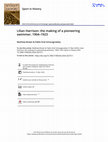
Sport in History, 2024
Lilian Harrison fue una nadadora sudamericana pionera que estableció nuevos récords de distancia ... more Lilian Harrison fue una nadadora sudamericana pionera que estableció nuevos récords de distancia de natación en aguas abiertas y de tiempo dedicado a nadar en diciembre de 1923, cuando se convirtió en la primera persona en cruzar a nado el Río de la Plata, desde Uruguay hasta Argentina. Hasta ahora, sus logros han sido recordados y estudiados como una historia sudamericana, desde el nacimiento de Harrison en Quilmes hasta su entrenamiento en Tigre, pasando por la tumultuosa recepción que recibió al regresar a Buenos Aires después de su exitoso nado. En este artículo, situamos los logros de Harrison dentro del contexto histórico de sus primeros años de vida y educación, que transcurrieron en una escuela idealista y pionera en Letchworth Garden City, Inglaterra. Sostenemos que la educación inglesa de Harrison fue un ingrediente vital en su éxito de 1923 que generalmente fue pasado por alto en los informes de prensa. Utilizando fuentes periodísticas existentes, así como periódicos familiares privados que hemos tenido la suerte de consultar, analizamos la educación de Harrison en la escuela, en la piscina y su crianza familiar. El artículo concluye con algunas reflexiones sobre la naturaleza de las historias del deporte mundial a principios del siglo XX.
Books by Matthew Brown
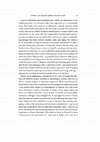
Sports in South America: A History, 2023
Sports in South America follows the transformation of sporting cultures in South America leading ... more Sports in South America follows the transformation of sporting cultures in South America leading up to Uruguay’s hosting of the first FIFA Men’s World Cup in 1930. Matthew Brown shows how South American soccer culture, envied worldwide, sprang out of societies that were already playing and watching games well before British sportsmen arrived to teach “the beautiful game.” These vibrant and distinct sporting traditions, including cycling, boxing, cockfighting, bullfighting, cricket, baseball, and horse racing, were marked by South American societies’ Indigenous and colonial pasts and by their leaders’ desire to participate in what they saw as a global movement toward human progress. Drawing on a wealth of original archival research, Brown debunks legends, highlights the stories of forgotten sportswomen and Indigenous sports, and unpacks the social and cultural connections within South America and with the rest of the world.
From Frontiers to Football: An Alternative History of Latin America since 1800, 2014
When published in 2014, From Frontiers to Football provided an introduction to Latin American his... more When published in 2014, From Frontiers to Football provided an introduction to Latin American history for newcomers and outsiders. This is the introduction.
Legacies of the Forgotten: Sporting Biographies from Pre-1930s South America, 2024
This book consists of ten biographies of South American sportspeople from before 1930. These are ... more This book consists of ten biographies of South American sportspeople from before 1930. These are supplemented by ten critical analyses of those biographies, situating them within their historical context and against contemporary scholarship. The authors were final-year undergraduates at the University of Bristol, on the Sports and Societies in South America unit in 2023-2024. The concept, design and title were all produced by the students.

Editorial Prometeo, 2024
El siguiente libro explora los modos discursivos y visuales en que la prensa general (periódicos ... more El siguiente libro explora los modos discursivos y visuales en que la prensa general (periódicos y magazines) y especializada (deportiva) nacional e internacional, así como los testimonios fílmicos describieron y, al mismo tiempo, fabricaron e interpretaron los distintos cruces a nado realizados por Lilian Harrison y los sentidos dominantes -y las fugas de sentido- que se construyeron sobre su condición femenina, su cuerpo, sus fluidos y su moral sexual en la década de 1920. Asimismo, el libro analiza los modos en que la prensa y las películas referidas a su actuación deportiva contribuyeron a construir ciertas narrativas identitarias, estéticas y sexuales. En este sentido, se considera la perfomance deportiva de Lilian Harrison como un ‘descriptor denso’ y una excusa para identificar las lógicas, dinámicas, tensiones y disputas sexuales, identitarias y generizadas producidas en el contexto social más amplio.
Vale decir, el desempeño deportivo de Lilian, su descripción e interpretación visual y discursiva hizo referencia menos a sus rendimientos deportivos y más a los imaginarios y representaciones sociales, sexuales y morales en pugna a nivel local y transnacional.
Para analizar dichos universos de sentidos, el presente libro se nutrió conceptual y epistemológicamente de cuatro grandes campos teóricos: la biografía histórica, la historia social y cultural de los deportes, el giro visual y los estudios de género. Estos enfoques y campos conceptuales fueron utilizados para explorar, analizar e interpretar una variedad de fuentes como por ejemplo la prensa nacional e internacional, películas nacionales y extranjeras, revistas escolares y discursos pedagógicos de la institución educativa inglesa donde estudió Lilian Harrison y testimonios a partir de entrevistas con los descendientes de Lilian Harrison que viven en Argentina y Estados Unidos, quienes nos abrieron sus hogares, sus archivos y sus memorias.
Aunque la práctica deportiva vinculada con la natación instaló narrativas cuasi hegemónicas sobre la feminidad, la diferencia sexual, la identidad, la sexualidad, la moral o la belleza, al mismo tiempo, coexistieron micro narrativas que intentaron impugnar, matizar o resistir las melodías discursivas y visuales dominantes. Ciertamente la historia de Lilian Harrison nos permite identificar otras caras y otros escenarios relacionados con las políticas corporales materializadas en los años ‘20, pero al mismo tiempo nos ayuda a reconocer cómo en la actualidad se escuchan, huelen y sienten los efectos del ‘olaje’ de sus cruces simbólicos, los cuales siguen estando presentes e incomodando a actores sociales androcéntricos dentro y fuera del universo deportivo.
48.1 (2021) Tema Libre by Matthew Brown
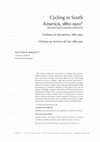
Anuario Colombiano de Historia Social y de la Cultura, 2021
Matthew Brown
https://revistas.unal.edu.co/index.php/achsc/article/view/91552
Historians have ten... more Matthew Brown
https://revistas.unal.edu.co/index.php/achsc/article/view/91552
Historians have tended to ignore the South American experience of cycling. The continent’s diverse history of sports has been effaced by a popular and academic focus on soccer. The global history of cycling has therefore omitted South America from its analysis, perpetuating mistaken assumptions about the continent’s absence from technological and social innovation. This article analyses the sources located across the continent to demonstrate that cyclists raced, toured, and did acrobatics, often watched by thousands of spectators, attracting the attention of chroniclers and the media. The physical sensations of travelling through the environment on a pedal-powered machine were new and unexpected. With its focus on cycling as sport, recreation and mode of transport, this article inserts South America into the early global history of cycling.
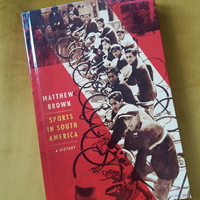










Uploads
Papers by Matthew Brown
translations of the rules of the game from English into Portuguese and Spanish. It demonstrates, by means of a
comparison of the different temporalities and contexts of these documents, the connected and transnational nature
of the sport. This has often been neglected in national paradigm studies of football pioneers and the first matches,
clubs and leagues. The study of the translators suggests new avenues for the study of the interlinked histories of
sport, politics and culture.
Books by Matthew Brown
Vale decir, el desempeño deportivo de Lilian, su descripción e interpretación visual y discursiva hizo referencia menos a sus rendimientos deportivos y más a los imaginarios y representaciones sociales, sexuales y morales en pugna a nivel local y transnacional.
Para analizar dichos universos de sentidos, el presente libro se nutrió conceptual y epistemológicamente de cuatro grandes campos teóricos: la biografía histórica, la historia social y cultural de los deportes, el giro visual y los estudios de género. Estos enfoques y campos conceptuales fueron utilizados para explorar, analizar e interpretar una variedad de fuentes como por ejemplo la prensa nacional e internacional, películas nacionales y extranjeras, revistas escolares y discursos pedagógicos de la institución educativa inglesa donde estudió Lilian Harrison y testimonios a partir de entrevistas con los descendientes de Lilian Harrison que viven en Argentina y Estados Unidos, quienes nos abrieron sus hogares, sus archivos y sus memorias.
Aunque la práctica deportiva vinculada con la natación instaló narrativas cuasi hegemónicas sobre la feminidad, la diferencia sexual, la identidad, la sexualidad, la moral o la belleza, al mismo tiempo, coexistieron micro narrativas que intentaron impugnar, matizar o resistir las melodías discursivas y visuales dominantes. Ciertamente la historia de Lilian Harrison nos permite identificar otras caras y otros escenarios relacionados con las políticas corporales materializadas en los años ‘20, pero al mismo tiempo nos ayuda a reconocer cómo en la actualidad se escuchan, huelen y sienten los efectos del ‘olaje’ de sus cruces simbólicos, los cuales siguen estando presentes e incomodando a actores sociales androcéntricos dentro y fuera del universo deportivo.
48.1 (2021) Tema Libre by Matthew Brown
https://revistas.unal.edu.co/index.php/achsc/article/view/91552
Historians have tended to ignore the South American experience of cycling. The continent’s diverse history of sports has been effaced by a popular and academic focus on soccer. The global history of cycling has therefore omitted South America from its analysis, perpetuating mistaken assumptions about the continent’s absence from technological and social innovation. This article analyses the sources located across the continent to demonstrate that cyclists raced, toured, and did acrobatics, often watched by thousands of spectators, attracting the attention of chroniclers and the media. The physical sensations of travelling through the environment on a pedal-powered machine were new and unexpected. With its focus on cycling as sport, recreation and mode of transport, this article inserts South America into the early global history of cycling.
translations of the rules of the game from English into Portuguese and Spanish. It demonstrates, by means of a
comparison of the different temporalities and contexts of these documents, the connected and transnational nature
of the sport. This has often been neglected in national paradigm studies of football pioneers and the first matches,
clubs and leagues. The study of the translators suggests new avenues for the study of the interlinked histories of
sport, politics and culture.
Vale decir, el desempeño deportivo de Lilian, su descripción e interpretación visual y discursiva hizo referencia menos a sus rendimientos deportivos y más a los imaginarios y representaciones sociales, sexuales y morales en pugna a nivel local y transnacional.
Para analizar dichos universos de sentidos, el presente libro se nutrió conceptual y epistemológicamente de cuatro grandes campos teóricos: la biografía histórica, la historia social y cultural de los deportes, el giro visual y los estudios de género. Estos enfoques y campos conceptuales fueron utilizados para explorar, analizar e interpretar una variedad de fuentes como por ejemplo la prensa nacional e internacional, películas nacionales y extranjeras, revistas escolares y discursos pedagógicos de la institución educativa inglesa donde estudió Lilian Harrison y testimonios a partir de entrevistas con los descendientes de Lilian Harrison que viven en Argentina y Estados Unidos, quienes nos abrieron sus hogares, sus archivos y sus memorias.
Aunque la práctica deportiva vinculada con la natación instaló narrativas cuasi hegemónicas sobre la feminidad, la diferencia sexual, la identidad, la sexualidad, la moral o la belleza, al mismo tiempo, coexistieron micro narrativas que intentaron impugnar, matizar o resistir las melodías discursivas y visuales dominantes. Ciertamente la historia de Lilian Harrison nos permite identificar otras caras y otros escenarios relacionados con las políticas corporales materializadas en los años ‘20, pero al mismo tiempo nos ayuda a reconocer cómo en la actualidad se escuchan, huelen y sienten los efectos del ‘olaje’ de sus cruces simbólicos, los cuales siguen estando presentes e incomodando a actores sociales androcéntricos dentro y fuera del universo deportivo.
https://revistas.unal.edu.co/index.php/achsc/article/view/91552
Historians have tended to ignore the South American experience of cycling. The continent’s diverse history of sports has been effaced by a popular and academic focus on soccer. The global history of cycling has therefore omitted South America from its analysis, perpetuating mistaken assumptions about the continent’s absence from technological and social innovation. This article analyses the sources located across the continent to demonstrate that cyclists raced, toured, and did acrobatics, often watched by thousands of spectators, attracting the attention of chroniclers and the media. The physical sensations of travelling through the environment on a pedal-powered machine were new and unexpected. With its focus on cycling as sport, recreation and mode of transport, this article inserts South America into the early global history of cycling.